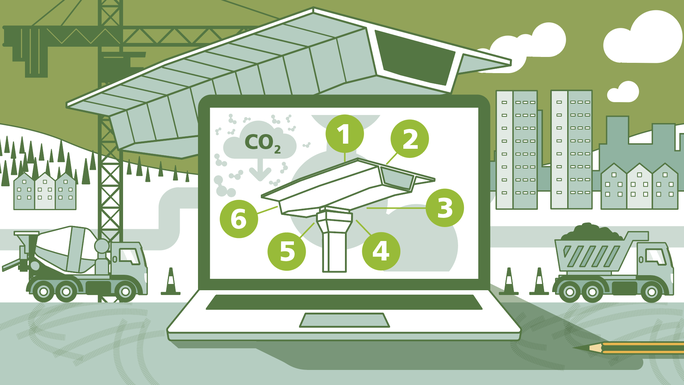Why engineers must play a key part in decarbonisation

Construction and operational activities in the built environment account for about half of the world’s greenhouse gas (GHG) emissions, according to estimates published by engineering consultant Arup.
The UN’s Intergovernmental Panel on Climate Change has called for an urgent reduction in such emissions to restrict global warming. Yet, despite making some progress, the sector is not responding quickly enough. In 2021, for instance, carbon dioxide (CO2) emissions from building operations surpassed their pre-pandemic peak by 2%.
Global greenhouse gas emissions under various UN Environment Programme scenarios and the 2030 emissions gap
Engineers must influence the projects they work on today to minimise their GHG emissions, because their actions will be judged by tomorrow’s standards.
The UK construction industry has long recognised the urgency of the situation. The PAS 2080 standard for carbon management in infrastructure, commissioned by the Construction Leadership Council (CLC) and the Green Construction Board (GCB), was a global first when it was originally published by the British Standards Institution (BSI) in 2016.
Sponsored by the GCB and the ICE, the BSI updated this standard in 2023. The revised PAS 2080 includes both infrastructure and buildings, reflecting their clear interdependencies. The ICE's associated Guidance Document, published alongside the PAS, provides practical advice and examples to aid built environment professionals in accelerating the decarbonisation of buildings and infrastructure.
Influencing decarbonisation across the project lifecyle

Stakeholders at all stages of the project lifecycle have a significant role to play in making carbon savings (credit: iStock/Laurence Dutton)
The complex and fragmented nature of construction and the built environment means that different stakeholders in a project have opportunities to make significant contributions to the decarbonisation effort at various stages.
“Each role has the potential to influence the carbon footprint differently,” says Beatriz García Navarro, standards manager at the Roundtable on Sustainable Biomaterials (RSB) and formerly carbon manager at HS2 (High Speed 2). She notes that decarbonising construction and operation requires a sustainable approach from the outset.
The impact and influence on emissions that various stakeholders can have at each lifecycle stage
Source: Call For Action: Seizing the Decarbonization Opportunity in Construction, McKinsey & Co
However, a GCB-sponsored progress report called Infrastructure Carbon Review: Seven Years On criticised the lack of cross-sector collaboration achieved by its time of publication in 2021. Asset owners simply must work more effectively with designers, contractors and suppliers on reducing whole-life and embodied carbon if the sector is to achieve its net-zero goals. Below is a summary of what each of these stakeholders can do to maximise their impact.
Asset owners
Asset owners are arguably the most influential stakeholders in the decarbonisation effort. García Navarro observes that they have considerable power at the system level, making decisions with long-term, lifecycle-wide implications.
To maximise their influence, asset owners must establish carbon targets for their projects, integrating these into their broader decarbonisation strategy by using key performance indicators (KPIs) and incentives that reward whole-life carbon reductions.
Regardless of their contract type, asset owners bear the ultimate accountability for projects, notes Ben Hellawell, senior project engineer at Transport for London. He says that addressing this responsibility requires “investment, tough decisions, decisive action and a new risk appetite to minimise the risks and maximise the benefits”.
Consider the recent flood protection scheme in Low Crosby, Cumbria, as an example of both the Environment Agency’s influence as an asset owner and the potential of nature-based engineering solutions. Instead of simply commissioning conventional defences, which are typically barriers made of carbon-intensive concrete, the agency engaged extensively with local farmers to restore about 185ha of agricultural land beside the River Eden back to natural floodplain.
This has so far prevented a repeat of the serious flood that struck the village in 2015 and will sequester an estimated 30,000 tonnes of CO2e over a 100-year assessment period.
Designers
Designers need to work with asset owners and contractors to assess where CO2 emissions are generated and work out a decarbonisation roadmap. This work should start by considering the potential of retrofitting.
“With roughly 80% of the predicted building stock for 2050 already in existence today, there is a huge need – and opportunity – to retrofit existing assets,” stressed McKinsey & Co in its 2021 Call for Action: Seizing the Decarbonization Opportunity in Construction.
The design stage offers opportunities to minimise CO2 emissions by optimising the use of resources and thereby reducing waste. For instance, a study of 23 UK buildings by the University of Cambridge in 2014 showed that more than 10,000 structural steel beams in those buildings were carrying only half of the load they were designed for.
The Guidance Document for PAS 2080 also stresses how important it is for designers to engage with all interested parties as early as possible in the life of a project. The designer’s task here, according to García Navarro, is to “collaborate with other stakeholders, including asset owners and contractors, and consider various aspects, including structure typology, materials and market engagement”.
James Richardson, associate director of sustainability at engineering consultant Jacobs, stresses the need for designers to “take ownership and pride in value engineering that encompasses low-carbon design”. He advocates moving away from pure “hard engineering” towards nature-based solutions and biogenic CO2 removal.
Contractors
Contractors have relatively little influence, given that they’re “lower in the hierarchy”, notes García Navarro, but she adds that they still have a “vital role to play in finding the best solutions”.
Contractors can apply low-carbon construction techniques; challenge design decisions and programme requirements to deliver greener outcomes; and monitor and report the whole-life CO2 emissions of projects. But they’re generally unable to take the initiative and go it alone. There’s a general aversion to using salvaged materials without knowing their exact properties, for instance.
Typically, the signal for contractors to act comes from the carbon targets of asset owners and/or regulatory standards. It’s therefore important that they get involved at the concept design stage to have proper input from the start and ensure effective collaboration.
Suppliers
Suppliers are responsible for promoting low-carbon materials and challenging specifications that would lead to more CO2 emissions than necessary. They are also expected to incorporate carbon management principles into their delivery systems and apply low-carbon procurement criteria.
Suppliers, notes García Navarro, are “the materials experts” who can introduce more sustainable alternatives to traditional products. Wood composites, for instance, offer a lighter yet robust substitute for steel and concrete. They combine a high load-bearing capacity with good insulating qualities and electrical resistance.
Recognising the value of suppliers’ knowledge, some large contractors and asset owners have started holding supplier conferences, encouraging suppliers to identify opportunities to decarbonise collectively.
The importance of leadership and culture

Effective leadership and training will be vital if the UK is to stand any chance of achieving net zero by 2050 (credit: iStock/Daniel Balakov)
Leadership and culture play a vital role in empowering engineers at all levels to focus on decarbonisation.
“Incorporating a carbon-conscious culture in the organisation is crucial,” says García Navarro, who stresses the importance of effective leadership. “Everyone needs to understand how to embed carbon in their roles; everyone needs training. That mindset is impossible to achieve if it’s not embraced from the top down.”
Watercare, the council-owned business that manages the water and wastewater services of Auckland, New Zealand, provides a case in point. In 2019, the company instilled a carbon-centred culture by introducing its so-called 40:20:20 vision. This targeted a 40% reduction in CO2 emissions, a 20% reduction in construction costs and a 20% year-on-year improvement in health and safety outcomes by 2024.
By setting an organisational strategy for carbon management – including striving to be the market leader – and establishing clear roles and responsibilities, its leadership team has ensured that carbon savings have become “everybody’s responsibility” at Watercare, according to the Guidance Document for PAS 2080.
Many businesses have recognised the transformational potential of the sustainability imperative. A McKinsey survey of 400 global industry leaders in 2020 found that 80% considered sustainability to be the most likely driver of a transformational shift in their industries over the medium term, for instance.
In UK construction, that’s been associated with the need for a significant increase in recruitment and training activity. The Construction Industry Training Board estimated in 2021 that the sector would need to increase its workforce by 350,000 within seven years for the UK to achieve net zero by 2050.
Incorporating a carbon-conscious culture in the organisation is crucial – that mindset is impossible to achieve if it’s not embraced from the top down
Beatriz García Navarro, standards manager, RSB
How to stay informed and motivated

The ICE offers a wide range of guidance, learning materials and initiatives to help its members keep up to speed with the decarbonisation drive (credit: iStock/Portra)
The fact that decarbonisation is a fast-moving field comes with positives as well as negatives for engineers trying to keep up with developments, says Hellawell, who would urge any engineer to be open about both their successes and their failures in the effort to cut the sector’s CO2 emissions.
Continuous improvement is a fundamental tenet of PAS 2080. When an innovative approach to delivering carbon reduction has been developed and embedded, it should become the new base position. Reporting is therefore vital to informing the daily carbon management process as well as future advances in the field.
García Navarro advocates integrating “carbon consciousness” into daily operations and training, to the extent of incorporating carbon KPIs alongside daily onsite health and safety briefings.
“Keeping up with all the changes in data science and related fields can be challenging, even for me,” she says. “It’s impossible to stay updated on everything outside your discipline. Instead, focus on staying connected with the topics that are most closely related to your work.”
Richardson offers the following checklist to help engineers stay informed and motivated:
- Commit to climate-related CPD activity.
- Become an industry decarbonisation leader.
- Co-write technical papers and enter competitions.
- Consider your own climate impacts outside work.
The ICE offers support in the shape of guidance and other publications, training, professional qualifications and industry initiatives. Your own CPD is a key part of the profession’s focus on accelerating decarbonisation through wider industry collaboration.
Sign up to receive news from ICE Knowledge direct to your inbox.





